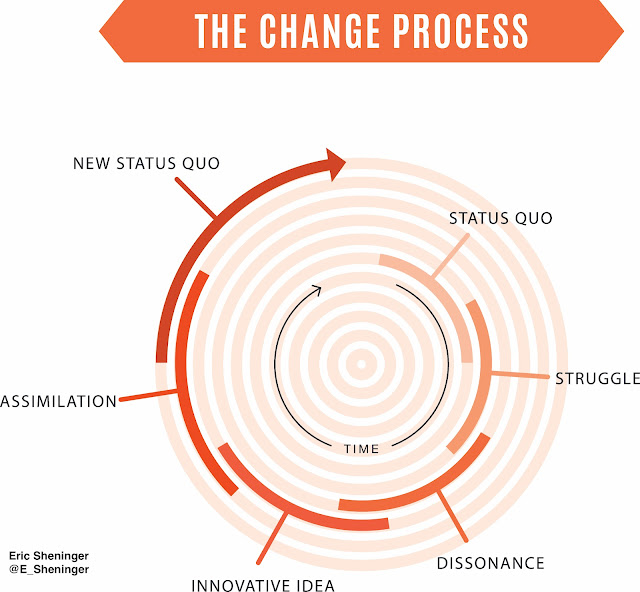Recently, on my podcast Unpacking the Backpack, I revisited a 2019 blog post outlining the stages of innovative change. Take a listen on Spotify or wherever you access your favorite podcasts. You can also read the blog post HERE. I have found great value in using the podcast to expand on ideas, concepts, and frameworks I have developed over the years. An unintended outcome has also materialized, which is using my blog to delve a little bit deeper by providing additional insight and thoughts. Let’s dive into the intricacies of innovative change!
Change is an inevitable part of growth, yet it is often accompanied by discomfort and resistance. When it comes to innovation in education or leadership, the process of transitioning from the familiar to the unknown can feel daunting. The Change Process resource I created for Digital Leadership (2nd Edition) offers a powerful visual and conceptual tool to help individuals and organizations understand and navigate the stages of transformation.
At its core, the Change Process is cyclical, illustrating how ideas evolve over time before becoming part of a new status quo. It begins with the status quo, the comfortable, familiar baseline from which we operate. Innovative ideas challenge this baseline, introducing a sense of disruption. This initial phase is exciting, but it often meets resistance as the idea tests the limits of established norms.
The next phase is struggle, where implementation begins. As new practices are introduced, the process often feels messy and overwhelming. Mistakes are made, challenges arise, and the temptation to revert to the old ways can be strong. However, this is the tipping point of the process. Resilience, persistence, and support are critical to navigating this stage. Leaders and teams must stay focused on the long-term vision, knowing that meaningful change is rarely linear or smooth.
As the change progresses, individuals and teams may enter the stage of dissonance. Here, doubt, fear, and uncertainty emerge as the gap between the old and the new becomes apparent. This stage is crucial—it forces reflection and lays the foundation for growth. While uncomfortable, dissonance encourages us to confront the barriers preventing progress. Leaders should view this phase as an opportunity to foster open dialogue, address concerns, and build trust.
The development of an innovative idea begins as a spark of possibility—a bold vision that challenges the status quo and offers a solution to existing problems or unmet needs. However, an idea alone isn’t enough; it requires nurturing to evolve into a practical and actionable concept. This involves collaboration, brainstorming, and testing to refine the idea into something feasible and scalable. During this phase, leaders must foster an environment that encourages creative thinking and risk-taking, allowing team members to experiment and explore without fear of failure. As the idea takes shape, early adopters and champions play a critical role in validating its potential, providing feedback, and building momentum for broader acceptance. These steps are crucial for transforming a fleeting concept into a robust initiative that can survive the challenges ahead.
Finally, through sustained effort, the process reaches assimilation. The new idea begins to take root, becoming a natural part of the organization’s culture and practice. Over time, what was once innovative becomes the new status quo, paving the way for future cycles of growth and change. Keep in mind that the key to innovation is a willingness to innovate and the inherent change this has brought to our learning.
The Change Process is a reminder that transformation is not an overnight journey—it requires time, patience, and adaptability. Always remember that innovation is more than an idea or tool. It also behooves us to know when to innovate or not. By understanding and embracing the stages of change, educators and leaders can navigate the challenges of innovation with confidence and clarity. As you reflect on your own change journey, remember that struggle and discomfort are not signs of failure but essential steps toward progress.


No comments:
Post a Comment